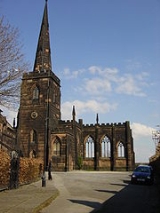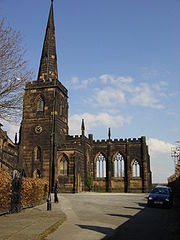
Birkenhead Priory
Encyclopedia

Birkenhead
Birkenhead is a town within the Metropolitan Borough of Wirral in Merseyside, England. It is on the Wirral Peninsula, along the west bank of the River Mersey, opposite the city of Liverpool...
, Merseyside
Merseyside
Merseyside is a metropolitan county in North West England, with a population of 1,365,900. It encompasses the metropolitan area centred on both banks of the lower reaches of the Mersey Estuary, and comprises five metropolitan boroughs: Knowsley, St Helens, Sefton, Wirral, and the city of Liverpool...
, England
England
England is a country that is part of the United Kingdom. It shares land borders with Scotland to the north and Wales to the west; the Irish Sea is to the north west, the Celtic Sea to the south west, with the North Sea to the east and the English Channel to the south separating it from continental...
. It is the oldest standing building on Merseyside. The remains of the priory
Priory
A priory is a house of men or women under religious vows that is headed by a prior or prioress. Priories may be houses of mendicant friars or religious sisters , or monasteries of monks or nuns .The Benedictines and their offshoots , the Premonstratensians, and the...
are a Grade I listed building and a Scheduled Ancient Monument
Scheduled Ancient Monument
In the United Kingdom, a scheduled monument is a 'nationally important' archaeological site or historic building, given protection against unauthorized change. The various pieces of legislation used for legally protecting heritage assets from damage and destruction are grouped under the term...
. It was founded about 1150 by Hamon de Masci, 3rd Baron of Dunham Massey for the Benedictine
Benedictine
Benedictine refers to the spirituality and consecrated life in accordance with the Rule of St Benedict, written by Benedict of Nursia in the sixth century for the cenobitic communities he founded in central Italy. The most notable of these is Monte Cassino, the first monastery founded by Benedict...
Order.
The Priory was visited twice by Edward I due to its strategic importance being close to the borders of Wales, and also the Irish Sea.
In 1318 the monks from Birkenhead Priory were granted ferry rights by Edward II
Edward II of England
Edward II , called Edward of Caernarfon, was King of England from 1307 until he was deposed by his wife Isabella in January 1327. He was the sixth Plantagenet king, in a line that began with the reign of Henry II...
. This allowed them to build a house in what is now Water Street to store their corn. The house was also used by travellers for shelter if the weather was too bad for the ferry to cross the River Mersey
River Mersey
The River Mersey is a river in North West England. It is around long, stretching from Stockport, Greater Manchester, and ending at Liverpool Bay, Merseyside. For centuries, it formed part of the ancient county divide between Lancashire and Cheshire....
.
The priory's chapter house
Chapter house
A chapter house or chapterhouse is a building or room attached to a cathedral or collegiate church in which meetings are held. They can also be found in medieval monasteries....
is consecrated as an Anglican church, and is still used for services. There is a chapel
Chapel
A chapel is a building used by Christians as a place of fellowship and worship. It may be part of a larger structure or complex, such as a church, college, hospital, palace, prison or funeral home, located on board a military or commercial ship, or it may be an entirely free-standing building,...
dedicated to the training ship HMS Conway
HMS Conway (school ship)
HMS Conway was a naval training school or "school ship", founded in 1859 and housed for most of its life aboard a 19th-century wooden battleship. The ship was originally stationed on the Mersey near Liverpool, then moved to the Menai Strait during World War II. While being towed back to Birkenhead...
. There is also a museum detailing the history of the site. The chapter house is a Grade II* listed building and contains items of Norman architecture
Norman architecture
About|Romanesque architecture, primarily English|other buildings in Normandy|Architecture of Normandy.File:Durham Cathedral. Nave by James Valentine c.1890.jpg|thumb|200px|The nave of Durham Cathedral demonstrates the characteristic round arched style, though use of shallow pointed arches above the...
. In 2005 the chapter house was restored.
St Mary's Tower was originally part of Birkenhead's first parish church
Parish church
A parish church , in Christianity, is the church which acts as the religious centre of a parish, the basic administrative unit of episcopal churches....
, opened in 1821 in the grounds of the priory. It is a Grade II listed building.
Redevelopment of the area from 1925 resulted in a large amount of residential housing within the parish being cleared to make way for the construction of the Queensway Tunnel
Queensway Tunnel
The Queensway Tunnel is a road tunnel under the River Mersey, in the north west of England, between Liverpool and Birkenhead. It is often called the Birkenhead Tunnel, to distinguish it from the Kingsway Tunnel, which serves Wallasey.-History:...
. An expansion of the Number 5 dry dock
Dry dock
A drydock is a narrow basin or vessel that can be flooded to allow a load to be floated in, then drained to allow that load to come to rest on a dry platform...
at the adjacent Cammell Laird
Cammell Laird
Cammell Laird, one of the most famous names in British shipbuilding during the nineteenth and twentieth centuries, came about following the merger of Laird, Son & Co. of Birkenhead and Johnson Cammell & Co. of Sheffield at the turn of the twentieth century.- Founding of the business :The Company...
shipyard in the 1960s resulted in the church losing a significant portion of its graveyard. Subsequent redevelopment of the approach roads to the Mersey Tunnel effectively cut off the church from most of what remained of its parish, further dwindling the congregation. St. Mary's Church closed in 1974 and was partly demolished a year later, for reasons of safety. Only the former church tower and parts of the outer walls remain. The tower has since been refurbished and is dedicated to those who died on HMS Thetis
HMS Thetis (N25)
HMS Thetis was a Group 1 T-class submarine of the Royal Navy which served under two names. Under her first identity, HMS Thetis, she commenced sea trials on 4 March 1939. She sank during trials on 1 June 1939 with the loss of 99 lives...
.
The churchyard contains the burial vault
Burial vault (tomb)
A burial vault is a structural underground tomb.It is a stone or brick-lined underground space or 'burial' chamber for the interment of a dead body or bodies. They were originally and are still often vaulted and usually have stone slab entrances...
of the Laird family, which includes John Laird (1805–74), Birkenhead's first Member of Parliament
Birkenhead (UK Parliament constituency)
Birkenhead is a parliamentary constituency represented in the House of Commons of the Parliament of the United Kingdom. It elects one Member of Parliament by the first past the post system of election.-History:...
and co-founder of the adjacent Cammell Laird shipbuilding company.

